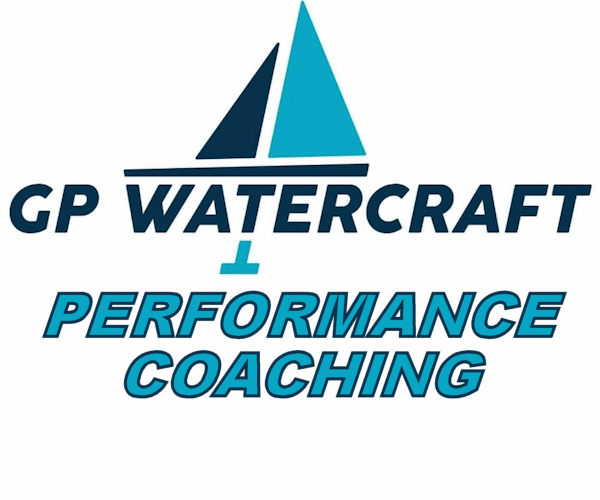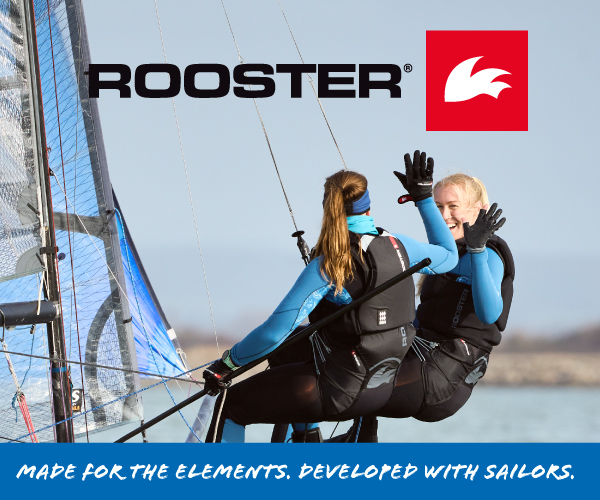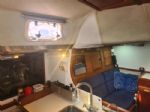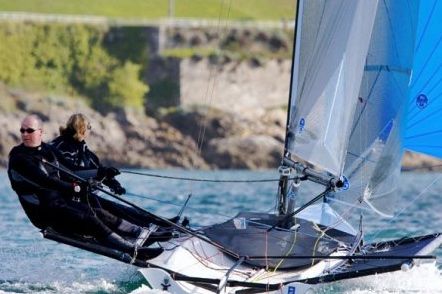





-(1)-202408140552.gif)






| Free mast for Merlin Rocket - has a bend! Guildford |
 |
| Bruce Roberts classic 45 Valencia, Spain |
 |
| Rossiter Pintail Mortagne sur Gironde, near Bordeaux |
 |
List classes of boat for sale |
Tomahawk |
Post Reply 
|
Page <1 7891011> |
| Author | |
Guests 
Guest Group 
|
 Post Options Post Options
 Quote Quote  Reply Reply
 Topic: Tomahawk Topic: TomahawkPosted: 13 Mar 09 at 9:47am |
|
The bi-plane config has been tried, but couldn't be made to work - you yo-yo up and down on the top foil I believe.
|
|
 |
|
Jon Howes 
Newbie 
Joined: 12 Mar 09 Online Status: Offline Posts: 6 |
 Post Options Post Options
 Quote Quote  Reply Reply
 Posted: 13 Mar 09 at 10:03am Posted: 13 Mar 09 at 10:03am |
|
As the foil was my concept I may be able to lay to rest some of the speculation regarding how it works. The facets towards the aft side of the upper surface are designed to ventilate progessively from rear to front as speed builds. When fully non-ventilated the section is highly cambered and generates a lift coefficient of around 0.77 and this gives a very low lift off speed. When fully ventilated (from the mid-chord aft facing step on the upper surface) the lift coefficient is 0.2. Between these two extremes there is a need for an intermediate condition so that, as the foil approaches the surface, sufficient speed has already been achieved to fully ventilate and no loss of lift occurs as the foil surfaces. I have missed out a lot of developmental steps here, but briefly, the pressure coefficient at the leading edge of the last facet is the lowest on the upper surface when completely unventilated and so giving an air path to this location (by an aft facing step or channel on the vertical strut) leads to early ventilation. The aft facing step on the facet tapers from root to tip and the step is swept (as is the foil). In combination these two features lead to a progressive ventilation growth across the span. By the time the ventilation is approaching the tip the next facet forwards is generating a healthy low pressure coefficient and the ventilation can either jump forwards from the aft facet or be fed to the step at the leading edge of the forward facet and a similar ventilation growth, and steady reduction in lift coefficient then occurs as speed continues to increase. By now the foil is approaching the surface and when it finally breaks out into surface running no sudden lift change occurs. The ventilation cavity follows the foil when submerged and, in design, is treated as an integral part of the foil section. As for drag, just like an aircraft, this is in two parts, lift induced drag and skin/profile drag. The profile drag of this family of sections is always higher than that of a conventional section if below cavitation speed, however the lift induced drag follows the same rules as any other lifting surface, ie, three things matter: wingspan, wingspan and wingspan. A comparison would be a lift to drag ratio (L/D) for a conventional section of around 100, for this section it is 22. When used on a 3D foil, the lift induced part becomes important and a conventional foil may then give around 12 to 15 whereas the ventilated section as we use it here gives about 10. In conclusion, upwind we will not beat a moth in moth conditions. With the wind free, after all the conventional foils have cavitated this thing will keep going and speed will be limited by nerve and structural failure. Note that this section was originally developed for my Monofoil project and is designed to behave beyond 100kts (getting there is another problem but if you don't design for it......). The foil on the dinghy will give simple sailing, low lift out speed, relatively shallow draft and, if the conditions and nerves allow, high speeds on the freer points of sailing. I notice the comments on combiantions of surface running foils with submerged foils below. We are experimenting with this on the dinghy rudder to give some tactile feed back to allow the correct incidence to be maintained. It could also be used to give crude ride height control to a submerged lifting foil but will obviously have problems if the speed increases sufficently for the submerged foil to lift the SR foil away from the surface. We put this in the patent application because you need to (?) but I do not have much faith in it as a design approach. On a sailboard it gets very interesting since cavitation will not occur, the board is kept away from wave impacts (and hence much of the source of drag on a planing board) and the span loading is reduced by at least a factor of two giving a much lower lift induced drag. If you want easy foiling go for the dinghy, if you want to scare yourself go for the board. Jon. Edited by Jon Howes |
|
 |
|
robinft 
Far too distracted from work 
Joined: 18 Jun 04 Location: Thorpe Bay YC Online Status: Offline Posts: 252 |
 Post Options Post Options
 Quote Quote  Reply Reply
 Posted: 13 Mar 09 at 10:30am Posted: 13 Mar 09 at 10:30am |
|
Great reply Jon, it stopped everyone in their tracks. Isn't it essentially what I said though?

|
|
|
Laser number 9
|
|
 |
|
Guests 
Guest Group 
|
 Post Options Post Options
 Quote Quote  Reply Reply
 Posted: 13 Mar 09 at 10:32am Posted: 13 Mar 09 at 10:32am |
|
Many thanks for that Jon - a very cunning design. I am very tempted to try one on my NS14... |
|
 |
|
Jon Howes 
Newbie 
Joined: 12 Mar 09 Online Status: Offline Posts: 6 |
 Post Options Post Options
 Quote Quote  Reply Reply
 Posted: 13 Mar 09 at 11:28am Posted: 13 Mar 09 at 11:28am |
|
Hi robinft, Yes, pretty much as you said: "Great question which I certainly can't answer but as a complete layman I did wonder if water flow is attached over the whole of the upper surface at low speed and then detaches leaving flow over 2 thirds and then one third as speed rises - hence the steps. The bottom surface is completely flat." And the bottom is not flat, it is designed for a constant chordwise load distribution which is close to (but not exactly) a concave parabola. The leading edge was difficult to design since the "ideal" for fully ventilated operation is a knife edge but this is both impractical, lead to the name "Tomahawk" and gives a tendency to stall at the slightest provocation. To see how I got round this you will need to read the patent!
Jon. Edited by Jon Howes |
|
 |
|
Chris 249 
Really should get out more 

Joined: 10 May 04 Online Status: Offline Posts: 2041 |
 Post Options Post Options
 Quote Quote  Reply Reply
 Posted: 13 Mar 09 at 11:29am Posted: 13 Mar 09 at 11:29am |
|
Jon, what is the span of the foils on a board? Are they as wide as a Formula
board? What happens about the lateral rolling effect some other foiler windsurfers have written about? |
|
 |
|
Jon Howes 
Newbie 
Joined: 12 Mar 09 Online Status: Offline Posts: 6 |
 Post Options Post Options
 Quote Quote  Reply Reply
 Posted: 13 Mar 09 at 11:40am Posted: 13 Mar 09 at 11:40am |
|
Would this be the same Chris 249 who has been so "supportive" of the Monofoil work? Listen for the crackling of flames......
|
|
 |
|
Jon Howes 
Newbie 
Joined: 12 Mar 09 Online Status: Offline Posts: 6 |
 Post Options Post Options
 Quote Quote  Reply Reply
 Posted: 13 Mar 09 at 11:50am Posted: 13 Mar 09 at 11:50am |
|
To add a bit of light and colour, here is the email I received from Linton after he first flew the sailboard (on Feb 4th): "Sam and I both sailed Oh my word!!!!!!!!!!!!!!!!!!!!!!!!!!!!!! That was the scariest bit of fun I have ever had. Damn it felt as though it was quick or as quick as I want to go! Apart from some side slippage issues and fin stall (which can happen on normal windsurfing) the board was really close to being very good. Jon I reckon I will soon have all the information you will need to properly design this. Buzzing Linton We will talk" Edited by Jon Howes |
|
 |
|
RodB 
Groupie 

Joined: 01 Sep 05 Location: United Kingdom Online Status: Offline Posts: 75 |
 Post Options Post Options
 Quote Quote  Reply Reply
 Posted: 13 Mar 09 at 4:38pm Posted: 13 Mar 09 at 4:38pm |
|
Jon
do you have details of the fin setup for the windsurfing option? I'd be interested in photos or a description. Are they prefitted to a std board or to a custom board only, if so what size board would you recommend? Could they possibly be retro fitted to a 2nd hand board? RodB |
|
 |
|
Rupert 
Really should get out more 
Joined: 11 Aug 04 Location: Whitefriars sc Online Status: Offline Posts: 8956 |
 Post Options Post Options
 Quote Quote  Reply Reply
 Posted: 13 Mar 09 at 4:55pm Posted: 13 Mar 09 at 4:55pm |
|
And the important question - will they be quicker down a speed trench than a normal windsurfer?
|
|
|
Firefly 2324, Puffin 229, Minisail 3446 Mirror 70686
|
|
 |
|
Post Reply 
|
Page <1 7891011> |
| Forum Jump | Forum Permissions  You cannot post new topics in this forum You cannot reply to topics in this forum You cannot delete your posts in this forum You cannot edit your posts in this forum You cannot create polls in this forum You cannot vote in polls in this forum |
Copyright ©2001-2010 Web Wiz
Change your personal settings, or read our privacy policy











 Printable Version
Printable Version Delicious
Delicious Digg
Digg Facebook
Facebook Furl
Furl Google
Google MySpace
MySpace Newsvine
Newsvine reddit
reddit StumbleUpon
StumbleUpon Twitter
Twitter Windows Live
Windows Live Yahoo Bookmarks
Yahoo Bookmarks Topic Options
Topic Options